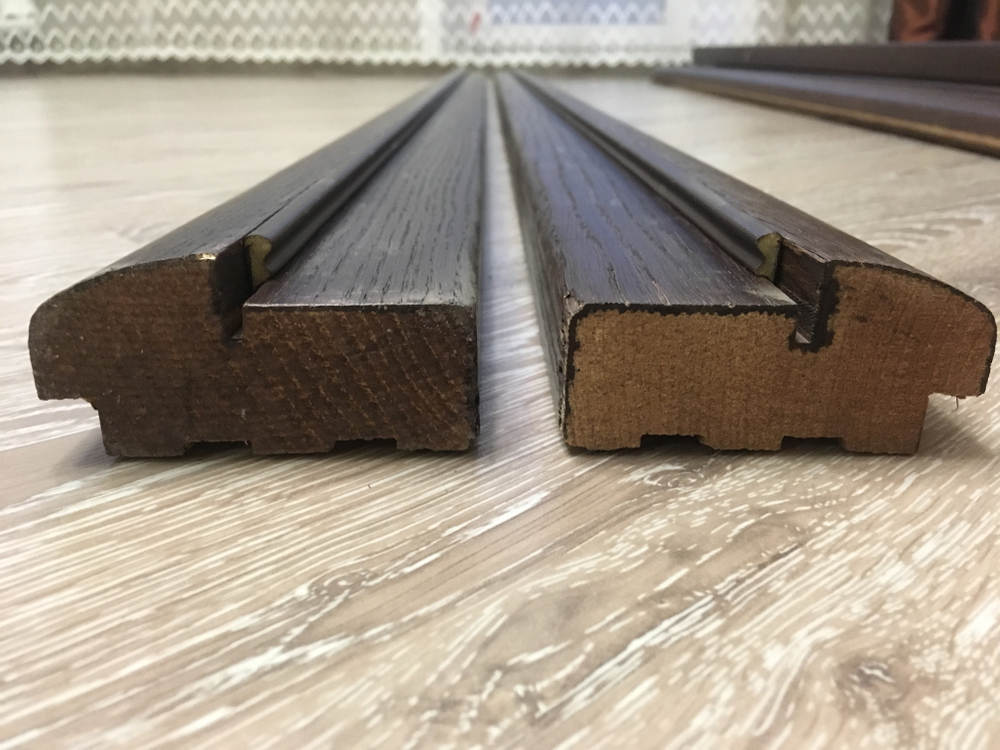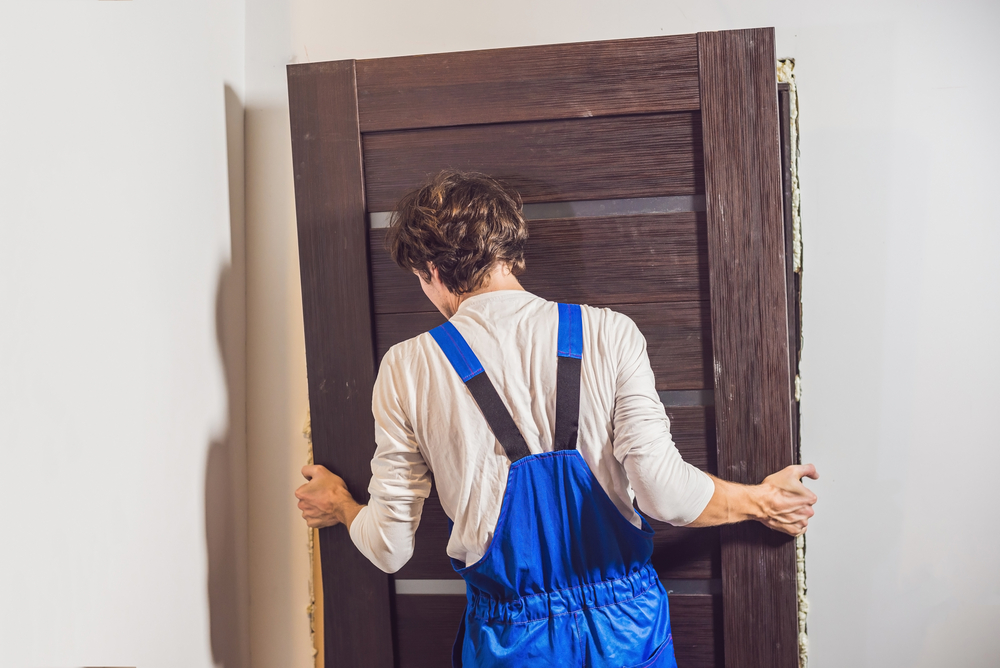Your home is your oasis. Whether you live in a bustling apartment complex or a standalone house, you should be able to relax at the end of a long day without your next-door neighbors or the passing traffic disrupting your thoughts. You should also be able to watch TV —or play an instrument, listen to music, or roughhouse with the kids— without worrying that you’ll bother said neighbors. Thankfully, soundproofing a door is a fairly easy task—as long as you know what you’re doing.
Some Easy Ways to Soundproof a Door

If you need to create a totally quiet environment —the kind a recording studio demands, for example— you’ll have to make extensive modifications to both the door and its surrounding frame. Such a project will inevitably be both highly labor intensive and exorbitantly expensive.
Fortunately, if you don’t require deafening silence and merely want to block out the worst of the surrounding chaos, there are a number of simple and affordable ways to soundproof your door without replacing it. Read on for some of the most effective strategies.
1. Upgrade the Threshold
If there’s even a small gap between the top of the threshold and the bottom of the door, a lot of sound is going to travel back and forth. Thankfully, replacing the threshold is a relatively straightforward job. In addition to the new threshold piece, you’ll need:
- A screwdriver
- A pry bar
- A hammer
- A hacksaw
- A tape measure
- Screws
Once you’ve gathered the necessary tools, take the following steps:
Step 1.
Unscrew any anchors that are holding the old threshold in place. Then, wedge a pry bar between the threshold and the door jamb, and tap it with a hammer to loosen it enough so you can lift off the entire piece. (If the threshold extends under the door jambs and you cannot use a pry bar, cut the piece down the middle using a hacksaw, and then slide out each half.)
Step 2.
Vacuum any dust, wood shavings, or debris left behind, and then measure the length of the space. Or, if you were able to get the old threshold out without cutting it, you can use it as a template.
Step 3.
Mark the appropriate length on the new threshold with a pencil. Use the hacksaw to cut it to size.
Step 4.
Slide the new threshold in place before securing it with screws. If the gap between the new threshold and the door is significantly smaller —but you can still close the door securely— consider it a job well done.
2. Apply Rubber Weatherstripping

The right kind of weatherstripping won’t only block cold drafts, but also unwanted noises. When installed on the sides and top of the frame, soundproofing rubber can reduce the amount of noise that passes through the door considerably. For even stronger protection, finish by applying acoustical caulk in any gaps or cracks that remain.
To apply rubber weatherstripping, you will need:
- Dense neoprene strips with an adhesive backing (measure the space between the frame and the closed door before purchasing the weatherstripping, to ensure you buy the right thickness)
- A tape measure
- A putty knife
- A utility knife
- Acoustical caulk
Once you have what you need, take the following steps:
Step 1.
If you’re replacing worn weatherstripping, use the putty knife to peel it off. Then, scrape away any left-behind caulk. Finally, wipe the bare frame down with a damp cloth to remove dust and dirt so the adhesive backing will stick securely. Follow with a dry cloth.
Step 2.
Standard doorframes need three neoprene strips for optimal sound protection: One along the top, and one lining each door jamb on the sides. Use the tape measure to determine the precise length for each strip, and then cut them accordingly.
Step 3.
Peel off the backing on one strip, and press it firmly to the doorframe. Follow the manufacturer’s instructions for ensuring strong adhesion. Repeat with the other two strips.
Step 4.
Make sure you can still close the door after all three strips have been applied. If you can’t, use the utility knife to slice off any excess rubber that’s in the way.
Step 5.
Once you can close the door, turn off the lights. If you notice any light pouring in from the outside, seal those cracks with acoustical caulk according to the manufacturer’s instructions.
3. Install an Acoustic Panel

If you’re not concerned with aesthetics, acoustic door panels can provide all the soundproofing you need. Typically comprised of foam, vinyl, or solid wood, these panels keep noise out by absorbing and/or dampening soundwaves. Flexible, rubbery materials absorb sound energy, while solid materials like wood dampen it.
Acoustic panels are generally sold in long rolls that range in thickness from about 1/16 inch to ¼ inch. The thicker the panel, the more sound protection it will provide.
Since the panel will be fairly heavy —even if you opt for the thinnest option— you’ll need help installing it. Once you have a buddy and a utility knife, a screwdriver, a tape measure, and construction adhesive, you’re ready to get started. Simply take the steps below.
Step 1.
If you’ll be covering the inside of the door and it swings outward, measure the portion of the door that’s exposed when it’s closed. Should you cover the entire door in paneling without accounting for a small gap around the perimeter, it won’t close properly. Then, use the screwdriver to remove the door from its hinges before laying it on your work surface with the side that will be paneled up.
Step 2.
If you’ll be covering the entire door in paneling and you don’t need to account for a gap so it will close, measure it after you’ve removed it from the hinges. Make sure to note the precise location of any knobs and locks while you work.
Step 3.
Lay the roll of paneling on the ground, and transfer the dimensions of the door to it. Once you’re sure you’ve marked everything accurately, cut the panel to the appropriate size using the utility knife. (Since the material is relatively expensive, make sure you’re confident with your measurements before you start cutting.)
Step 4.
Wipe down the door with a damp cloth so it’s free of dust and dirt. Follow with a dry cloth, or let it air dry. Then, apply the construction adhesive to the side of the panel that will be touching the door.
Step 5.
With your buddy’s help, pick up the panel and position it on the door, with the adhesive side down. Have your buddy hold it in place while you walk around the door and inspect it closely. Make any adjustments as needed to ensure proper alignment.
Step 6.
After waiting the recommended time for the adhesive to dry, reattach the door to its hinges, and put it back in place with your buddy’s help.
Closing Thoughts
While each of these methods will block a considerable amount of noise on its own, they’re most effective when used together. Fortunately, all three tasks are simple enough that you can complete them in a single afternoon, once you acquire all the necessary tools and materials. If you devote just a few hours to soundproofing the door in the ways described above, your family will get to enjoy peace and quiet in the comfort of home for years to come.
